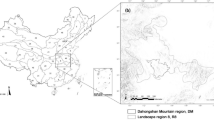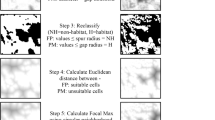Abstract
This paper presents a method for characterizing the complexity of landscape boundaries by remote sensing. This characterization is supported by a new boundary typology, that takes into account points where three or more landcovers converge (i.e., convergency points or coverts). Landscape boundary richness and diversity indices were proposed and calculated over 19 landscapes in South-East Brazil. Results showed that landscape boundaries, especially convergency points, provided an enrichment in landscape pattern analysis. Landcover boundary diversities were significantly related to landcover shape: elongated riparian units had the highest values for boundary diversity and coverts proportion indices. On the other hand, landscape analysis showed that indices of shape, richness, diversity and coverts proportion provided an additional evaluation of landcover spatial distribution within the landscape.
Similar content being viewed by others
References
Burrough, P.A. 1981. Fractal dimensions of landscapes and other environmental data. Nature 294: 240–242.
Burrough, P.A. 1986. Principles of geographic information systems for land resources assessment. Clarendon Press, Oxford.
Décamps, H. and Tabacchi, E. 1994. Species richness in vegetation along river margins.In Aquatic ecology: scale, pattern and process, pp. 1–20. Edited by P.S. Giller, A.G. Hildrew and D.G. Raffaelli. Blackwell Scientific Publications, Oxford.
Forman, R.T.T. and Godron, M. 1981. Patches and structural components for a landscape ecology. BioScience 31: 733–740.
Forman, R.T.T. and Godron, M. 1986. Landscape ecology. Wiley and Sons Ed., New York.
Fortin, M.-J. 1994. Edge detection algorithms for two-dimensional ecological data. Ecology 75: 956–965.
Gates, J.E. and Gysel, L.W. 1978. Avian nest dispersion and fledging success in field-forest ecotones. Ecology 59: 871–883.
Giometti, A.L.B.R. 1993. Contribuição ao diagnóstico e macro-zoneamento da bacia hidrográfica do rio Jacaré-Pepira-SP. Master thesis, State University of São Paulo, Rio Claro.
Hansen, A. and di Castri, F. 1992. Landscape boundaries: consequences for biotic diversity and ecological flows. Scientific Committee on Problems of the Environment book series, Springer-Verlag, New York.
Harris, L.D. and Kangas, P. 1979. Designing future landscapes from principles of form and function.In Our National Landscape, Techniques for Analysing and Management of Visual Resources, pp. 725–729. Washington, D.C.: U.S. Dept. Agric., Forest Service, General Technical Report PSW-35.
Holland, M.M. (Compiler). 1988. SCOPE/MAB Technical consultations on landscape boundaries. Report of a SCOPE/ MAB workshop on ecotones.In A new look at ecotones. Emerging international projects on landscape boundaries, pp. 47–106. Edited by A.F. di Castri, A.J. Hansen and M.M. Holland. Biology International, Special Issue 17, IUBS, Paris.
Holland, M.M., Risser, P.G. and Naiman, R.J. (Eds.). 1991. Ecotones. The role of landscape boundaries in the management and restoration of changing environments. Chapman and Hall, New York, London.
Johnston, C.A. and Bonde, J. 1989. Quantitative analysis of ecotones using a Geographic Information System. Photogrammetric Engineering & Remote Sensing 55: 1643–1647.
Johnston, C.A., Pastor, J. and Pinay, G. 1991. Quantitative methods for studying landscape boundaries.In Landscape boundaries. Ecological studies, pp. 107–125. Edited by A.J. Hansen and A.F. di Castri. Springer-Verlag, New York.
Krummel, J.R., Gardner, R.H., Sugihara, G., O'Neill, R.V. and Coleman, P.R. 1987. Landscape patterns in a disturbed environment. Oikos 48: 321–324.
LaGro, Jr. J. 1991. Assessing patch shape in landscape mosaics. Photogrammetric Engineering & Remote Sensing 57: 285–293.
Li, H. and Reynolds, J.F. 1993. A new contagion index to quantify spatial patterns of landscapes. Landscape Ecology 8: 155–162.
Li, H., Franklin, J.F., Swanson, F.J. and Spies, T.A. 1993. Developing alternative forest cutting patterns: a simulation approach. Landscape Ecology 8: 63–75.
Lovejoy, T.E., Bierregaard, Jr. R.O., Rylands, A.B., Malcolm, J.R., Quintela, C.E., Harper, L.H., Brown, Jr. K.S., Powell, A.H., Powell, G.V.N., Schubert, H.O.R. and Hays, M.H. 1986. Edge and other effects of isolation on Amazon forest fragments.In Conservation Biology: The science of scarcity and extinction, pp. 257–285. Edited by M.E. Soulé. Sinauer Associates, Sunderland, Mass.
Maier, M.H. 1983. Geoecologia, hidrografia, hidroquímica, clima e processos antrópicos da bacia do rio Jacaré-Pepira (SP). Ph.D. thesis, Federal University of São Carlos, São Carlos.
Meijerink, A.M.J. 1985. Geo information systems for land use zoning and watershed management. ITC Journal 1985-4: 283–287.
Naiman, R.J., Décamps, H., Pastor, J. and Johnston, C. 1988. The potential importance of boundaries to fluvial ecosystems. J. N. Benthol. Soc. 7: 289–306.
Naiman, R.J. and Décamps, H. (Eds.) 1990. The ecology and management of aquatic-terrestrial ecotones. Parthenon, Carnforth and UNESCO, Paris.
Olsen, E.R., Ramsey, R.D. and Winn, D.S. 1993. A modified fractal dimension as a measure of landscape diversity. Photogrammetric Engineering & Remote Sensing 59: 1517–1520.
Pinay, G. and Décamps, H. 1988. The role of riparian woods in regulating nitrogen fluxes between the alluvial aquifer and surface water: a conceptual model. Regulated Rivers: Research and Management 2: 507–516.
Romme, W.H. 1982. Fire and landscape diversity in subalpine forests of Yellowstone National Park. Ecological Monographs 52: 199–221.
Serra, J. 1982. Image analysis and mathematic morphology. Academic press, New York.
Strahler, A.M. 1957. Quantitative analysis of watershed geomorphology. Transactions, American Geophysical Union 38: 913–920.
Tabacchi, E. 1995. Structural variability and invasions of pioneer plants community in riparian habitats of the Middle Adour River. Canadian Journal of Botany 73: 33–44.
Turner, M.G. and Ruscher, C.L. 1988. Changes in the spatial patterns of land use in Georgia. Landscape Ecology 1: 241–251.
Warner, W.S. 1990. Accuracy and small-format surveys: the influence of scale and object definition on photo measurements. ITC Journal 1990–1: 24–28.
Wiens, J.A., Crawford, C.S. and Gosz, J.R. 1985. Boundaries dynamics: a conceptual framework for studying landscape ecosystems. Oikos 45: 421–427.
Wiens, J.A., Stenseth, N.C., Horne, B. Van and Ims, R.A. 1993. Ecological mechanisms and landscape ecology. Oikos 66: 369–380.
Zipperer, W.C. 1993. Deforestation patterns and their effects on forest patches. Landscape Ecology 8: 177–184.
Author information
Authors and Affiliations
Rights and permissions
About this article
Cite this article
Metzger, J.P., Muller, E. Characterizing the complexity of landscape boundaries by remote sensing. Landscape Ecol 11, 65–77 (1996). https://doi.org/10.1007/BF02093740
Issue Date:
DOI: https://doi.org/10.1007/BF02093740




